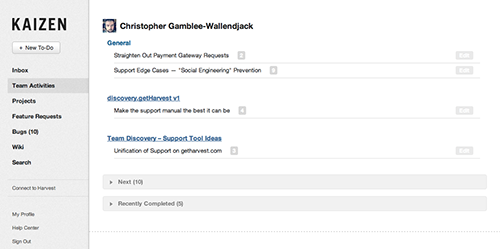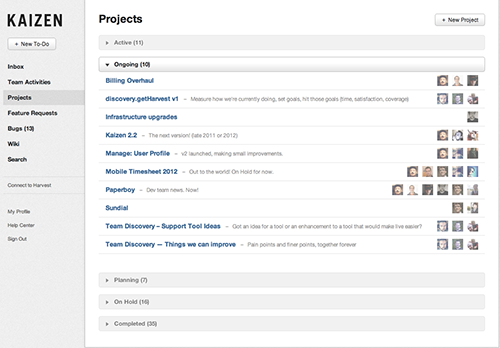While working on a different post today, I realized that we’ve never formally talked about Kaizen, our internal project management/bug tracker/feature request tracker. Sure, we’ve mentioned it in passing a number of times, but we’ve never given you a behind the scenes peek at what Kaizen looks like.
“Kaizen” is a Japanese word meaning “improvement” and refers to a philosophy of continuous improvement of process. It’s the perfect name for a tool that contributes so deeply to the improvement of our products, ourselves and the work we do. In a lot of ways, Kaizen (app) is the embodiment of The Harvest Way: listen to our customers, make it simpler, make it faster, be honest and keep improving.
Kaizen as a project/task manager:
Kaizen allows us to create projects with milestones and create tasks for each of those milestones. While there are about a million apps like that online but in this case we opted to re-invent the wheel for a few reasons.  Each task has it’s own comment thread, can be assigned to an individual, and can be marked completed when it’s finished. Tasks can also be converted to Feature Requests or Bugs with a single click. Folks can prioritize their own workload by keeping a task in their inbox, or by moving an item to “Next”, which is sort of like an incubator for ideas that aren’t quite ready. Tasks allow us to see, in the project view, who is working on what at any given time:
Each task has it’s own comment thread, can be assigned to an individual, and can be marked completed when it’s finished. Tasks can also be converted to Feature Requests or Bugs with a single click. Folks can prioritize their own workload by keeping a task in their inbox, or by moving an item to “Next”, which is sort of like an incubator for ideas that aren’t quite ready. Tasks allow us to see, in the project view, who is working on what at any given time:
Kaizen as a Bug Tracker:
This may come as a shock to some, but Harvest isn’t perfect! We will occasionally have a bug creep in to the system and Kaizen plays a key role here. Kaizen lets us keep track of reported bugs, who’s reported them and keep tabs on what’s going on/whether a fix is pending. Bugs can have a low, normal or “burning” priority and are assigned by our Delta Force team.
Once a bug is added to Kaizen, our Delta Force lead will review it and assign it to the appropriate person (or send it back to the support team if they need further clarification). The assignee will then start working through the bug, to identify where the problem is, if it can be reproduced, and how it should be fixed. Once that fix is in place, they’ll open up a pull request on github (which is automatically noted in Kaizen, giving us in support a heads up that a fix is about a day away).
Kaizen as a Feature Request tracker:
Every feature request we hear about from people is logged in Kaizen, whether that’s through email, Twitter, Facebook or over the phone. Kaizen is completely searchable, so we’ll first check to see if a request is “already in the system” or if we need to create a new ticket for it. Regardless of if it’s new or already there, we’ll do 3 things:
- We’ll increment the “count” on that request.
- We’ll record an email address or Twitter handle (if available) for the person making the request.
- We’ll enter in a comment describing what that individual is looking for. If we received a written request, we’ll usually just copy and paste the text from the request.
Then, when we decide that it’s time to get moving on Feature XYZ, our design and development team can pull up all related requests in Kaizen, and read over a thread of all of the correspondence we’ve had on that request. We really do consider everybody’s opinion when developing Harvest, and keeping track of it in Kaizen lets us stay focused on the customers’ needs.
There’s no option to mark Feature Requests as “done” in Kaizen — and no option to delete them. We either convert it to a to do, and complete it or it stays in the list. Because of that, the list has gained a few duplicates over the years, but, our intern Anthony built in a handy way to merge requests together. That’s really helped us to clean things up.
Kaizen came in handy during our recent launch of the new Stripe integration. Kaizen let us track the flood of requests we’ve received for Stripe support and then get in touch with a few folks who had requested the addition so that they could test it out for us. We touched base with some folks by email and others through Twitter. By having people write in to us, we had a record of their email addresses and it was really easy to get in contact with a few select people.
There’s your quick behind the scenes tour. I’m happy to take questions about anything Kaizen-related, or process-related below!
















